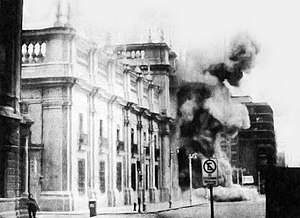General Discussion
Related: Editorials & Other Articles, Issue Forums, Alliance Forums, Region Forums1973 Chilean coup d'tat (cia backed)
1973 Chilean coup d'état
1973 Chilean coup d'état
Part of the history of Chile and the Cold War

The bombing of La Moneda on 11 September 1973 by the Junta's Armed Forces
Date 11 September 1973
Location Chile
Action Armed forces put the country under military control. Little and unorganized civil resistance.
Result
Popular Unity government overthrown
Salvador Allende committed suicide
Military Junta Government led by General Augusto Pinochet assumed power
Belligerents
Chile Chilean Government
Flag of the MIR - Chile.svg Revolutionary Left Movement
"Group of Personal Friends"
Other working-class militants[1]
Supported by:
Cuba
Soviet Union[2]
Chile Chilean Armed Forces
Chilean Army
Chilean Navy
Chilean Air Force
Carabineros de Chile
Supported by:
United States United States[3][4][5]
Commanders and leaders
Chile Salvador Allende †
Chile Max Marambio
Flag of the MIR - Chile.svg Miguel Enríquez
Cuba Fidel Castro Chile Augusto Pinochet
Chile José Toribio Merino
Chile Gustavo Leigh
Chile César Mendoza
United States Richard Nixon
United States Henry Kissinger
Casualties and losses
46 GAP
60 in total during the coup
Operation Condor
Background histories
Argentina Bolivia Brazil (1960s) Chile (1973 coup d'état) Paraguay Peru Uruguay
Events
Dirty War National Reorganization Process Operation Colombo Operation Charly Operation Gladio Night of the Pencils Operation Independence Ezeiza massacre Margarita Belén massacre Death flights Desaparecidos (the "disappeared"![]() 1973 Chilean coup d'état
1973 Chilean coup d'état
Government leaders
Jorge Anaya Hugo Banzer Basilio Lami Dozo João Figueiredo Leopoldo Galtieri Augusto Pinochet Alfredo Stroessner Jorge Rafael Videla
Targeted militias
Montoneros Tupamaros
People's Revolutionary Army (ERP)
Revolutionary Left Movement (MIR)
Principal operatives
Alfredo Astiz Orlando Bosch Hugo Campos Hermida Manuel Contreras Stefano Delle Chiaie José López Rega Virgilio Paz Romero Luis Posada Carriles Paul Schäfer Michael Townley
Organizations responsible
Dirección de Inteligencia
Nacional (DINA)
Caravan of Death
Batallón de Inteligencia 601
Coordination of United Revolutionary
Organizations (CORU)
National Intelligence
Service of Brazil (SNI)
School of the Americas (SOA)
Servizio per le Informazioni e
la Sicurezza Militare (SISMI)
Argentine Anticommunist
Alliance ("Triple A"![]()
Central Intelligence Agency (CIA)
Places
Esmeralda Estadio Nacional de Chile Villa Grimaldi Colonia Dignidad
Navy Petty-Officers School
of Mechanics (ESMA)
Laws
Full stop Due Obedience
Archives and reports
Archives of Terror Rettig Report Valech Report National Security Archive
Reactions
National Commission on the
Disappearance of Persons (CONADEP)
Trial of the Juntas
Augusto Pinochet's arrest and trial
The 1973 Chilean coup d'état was a watershed event in both the history of Chile and the Cold War. Following an extended period of social unrest and political tension between the right-controlled Congress of Chile and the socialist President Salvador Allende, as well as economic warfare ordered by US President Richard Nixon,[6] Allende was overthrown by the armed forces and national police.[7][8]
The military deposed Allende's Popular Unity government and later established a junta that suspended all political activity in Chile and repressed left-wing movements, especially the communist and socialist parties and the Revolutionary Left Movement (MIR). Allende's appointed army chief, Augusto Pinochet, rose to supreme power within a year of the coup, formally assuming power in late 1974.[9] The United States government, which had worked to create the conditions for the coup,[10] promptly recognized the junta government and supported it in consolidating power.[11]
During the air raids and ground attacks that preceded the coup, Allende gave his last speech, in which he vowed to stay in the presidential palace, refusing offers of safe passage should he choose exile over confrontation.[12] Direct witness accounts of Allende's death agree that he killed himself in the palace.[13][14]
Before the coup, Chile had for decades been hailed as a beacon of democracy and political stability while the rest of South America had been plagued by military juntas and Caudillismo. The collapse of Chilean democracy ended a streak of democratic governments in Chile, which had held democratic elections since 1932.[15] Historian Peter Winn characterized the 1973 coup as one of the most violent events in Chile's history.[16] A weak insurgent movement against the Pinochet regime was maintained inside Chile by elements sympathetic to the former Allende government. An internationally supported plebiscite in 1988 led Pinochet to relinquish power.
. . . . .
https://en.wikipedia.org/wiki/1973_Chilean_coup_d%27%C3%A9tat